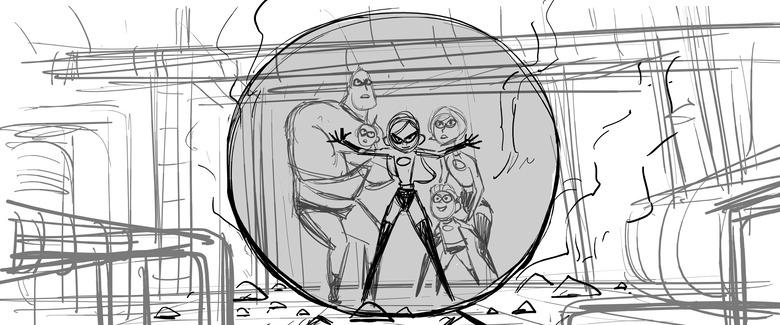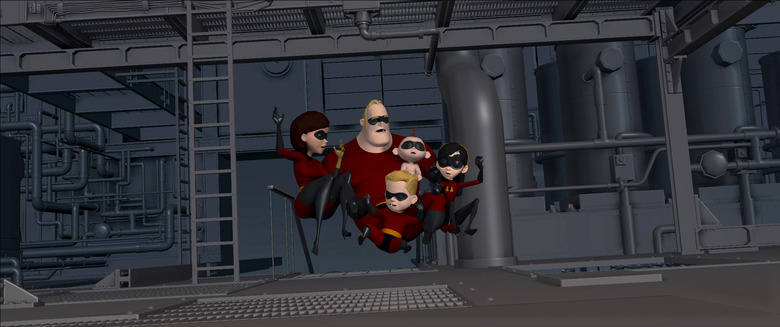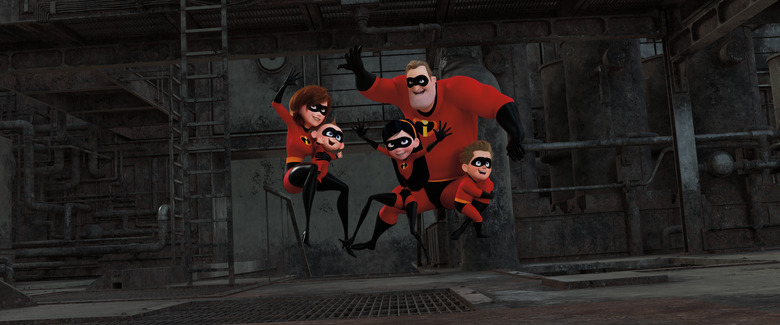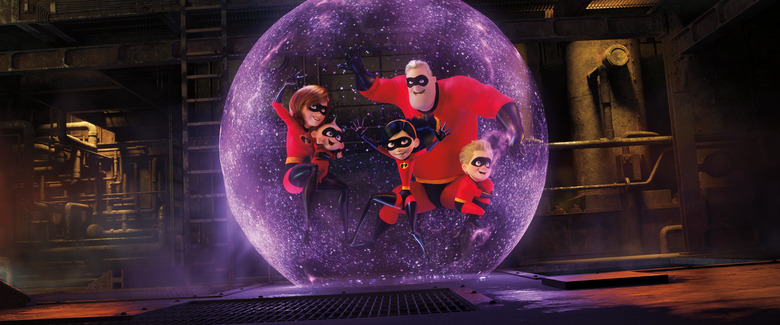See How A Shot From 'Incredibles 2' Evolves From Storyboard To Final Animation
Making an animated film is remarkably different than shooting a live-action movie. Everything is created from scratch, and the process is a much longer, arduous one. Sure, some live-action movies can take awhile to develop and get off the ground, but the amount of production time for an animated movie takes years.
Incredibles 2 has been in the works for 14 years, and the production timetable got pushed up when the original 2019 release date was swapped with the 2018 release of the delayed Toy Story 4. That means the team had to work a little faster to get the film done on time, and we've got a look at how a single shot from the animated sequel evolves from a simple storyboard to a meticulously detailed final shot.
Storyboarding
Here's a storyboard by Bobby Rubio from Incredibles 2 featuring Violet using her forcefield generating powers to protect the rest of The Incredibles inside the Underminer's vehicle. Storyboards help filmmakers pre-visualize each shot from the movie as the script is being written. They're placed in order to give a good idea of how the story will unfold. As you can see, the art has style, but it's an extremely simple representation of what we'll ultimately see on screen.
This particular scene is the opening action sequence of the movie featuring The Incredibles trying to stop the Underminer from robbing a bank and making an escape. Roughly 410 storyboards were created to plan this sequence alone. The entire movie was comprised of 52,725 storyboards.
Concept Art
Once the storyboards are complete and the storyline is solidified to satisfaction (though it can change at any point during the production process), the next step is to create concept art. This is where the film's production designer and art department create the look and feel of the film. This concept art ends up in what is called a color wall, giving an idea of the visual progression and evolution of the film. But since Incredibles 2 was bumped up to an earlier release, there wasn't a color wall on display.
Instead, this is one of the many pieces of concept art from production designer Ralph Eggleston that allows more detailed planning of sequences and shots and provides a frame of reference for animators to know what they're going to be creating. The point of these images is to put forth an idea of what kind of colors and design are wanted for the characters, environments and more.
Sets and Layout
After the concept art is finished, the next step is to have the technical artists build the basic shapes that will form the sets and characters that will be animated later. This process is called modeling. After that, artists begin what is called shading, painting characters and sets, applying textures, patterns and other material properties to make what's seen on screen start to look a little more realistic, at least relative to the style of the production.
The image above comes from the overall process known as layout. A virtual camera is placed into a shot in order to give animators an idea of how this particular scene will be constructed. During this process, the characters are"staged," or roughly posed and animated into positions within the built set that work visually with the chosen camera angle. The staging informs the director, editor and animators of the composition, timing and acting intention of the shot.
Animation
Once the camera angle in a given shot is determined and the characters are placed in the environment, it's up to the animation department to bring those characters to life. You'll see that the characters are now in action, posing as they will be seen in the shot. In order to recreate the characters as realistically as possible, animators use video reference of themselves, sometimes the voice actors, in order to make the character movement genuine.
During this process, characters have their facial expressions and body movement completed. Typically, it takes Pixar four to six weeks to complete animation for a single shot. In this particular case, the composition of the characters in this shot was so complex that the animation department needed eight weeks to finish it. But you'll notice that the environment around the characters still lacks definition and the shot doesn't feel complete. That comes in the final step.
Lighting and Effects (Final Image)
In the final part of the process, lighting and various effects are applied to create the fully realized image. The lighting involves creating virtual light sources to illuminate the characters and the set, just as a real life crew would do on a live-action film set. The lighting is placed in areas that will naturally call attention to what filmmakers want the audience to pay attention to. It also helps create a certain mood and tone for any given scene. Once the images have been lit, they're rendered at high resolution. Each frame of Incredibles 2 has over 2 million pixels, and there are 24 frames for each single second of the movie.
Along with the lighting, plenty of other final elements are added to the image. This includes things like dust and smoke, as well as the glow of Violet's forcefield, which in itself acts as a source of light and reflects off the floor of the set. To make the creation of these elements easier, the animators use simulation software that mimics the physics of the real world. However, sometimes the animators intentionally violate the rules of physics in order to make a shot more visually appealing or fit the style of the story a little better.
***
Part of me wishes I could see the progress of an animated movie from the beginning to the end and just watch the animators work for hours. I'm fascinated by how this entire world is created from scratch and how the scenes we see on the big screen evolve from the most simple art into complex, richly detailed images. Maybe someday a VR experience will allow fans to explore the virtual environments and get an up close look at the meticulous detail that goes into creating each and every shot of a Pixar movie.
For more on Incredibles 2, check out our reaction to 35 minutes of footage over here. Plus, you can learn more about the new wannabe supers debuting in the sequel and get some intriguing details about the villain known as The Screen Slaver.
Incredibles 2 hits theaters this summer on June 15, 2018.





